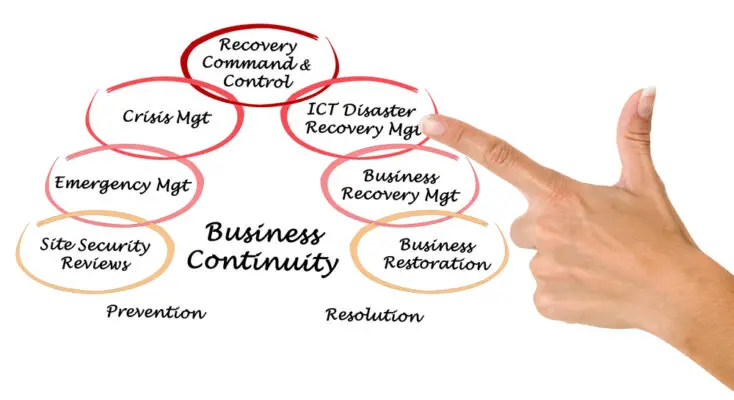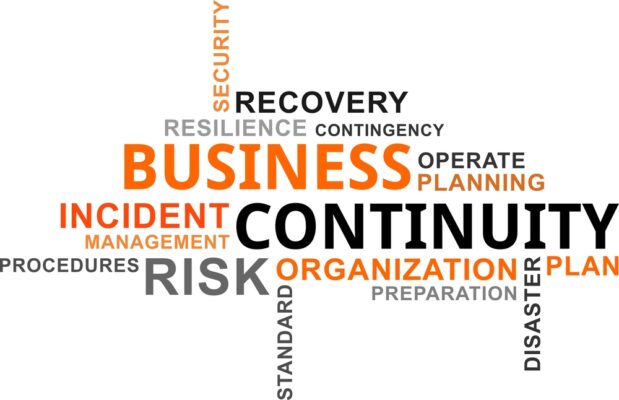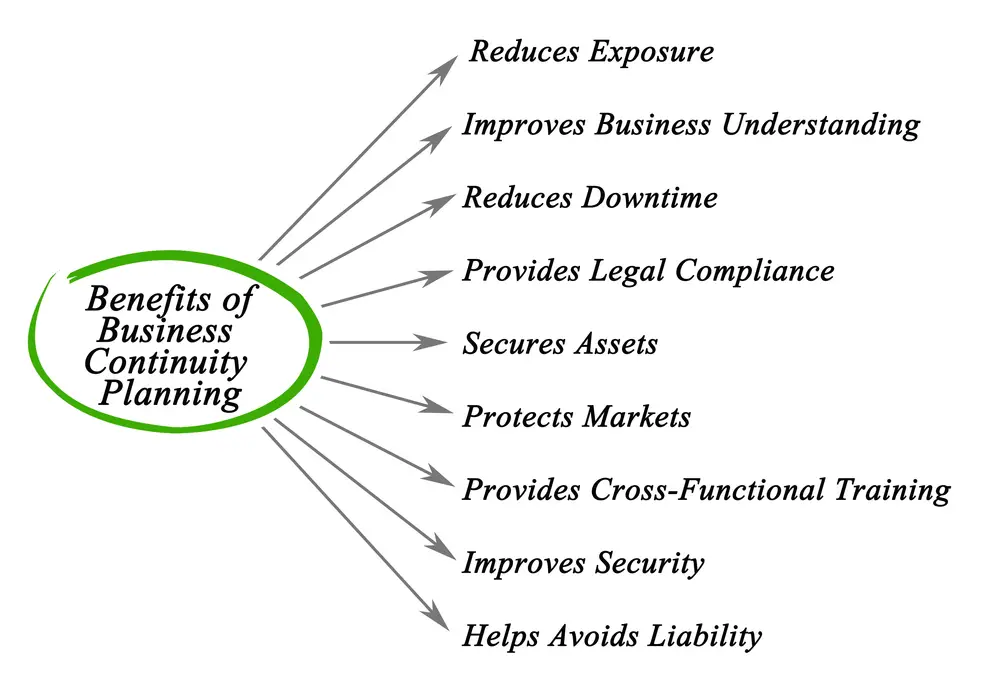A Business Continuity Management System (BCMS) is an organized system that helps businesses plan for unexpected events. It’s designed to help businesses protect their assets, operations, and profits in the event of a disaster or disruptive event even small businesses should benefit from this.
BCMSs are becoming increasingly popular as companies take steps to ensure that their business remains operational during a crisis. In this blog post, we’ll discuss what BCMSs is and provide an example of one.
What Does a BCMS do?
A BCMS is designed to help organizations identify risks associated with their operations and create strategies to mitigate them, as well as develop policies and procedures that can be followed in the event of a disaster or emergency. The goal is to have a plan in place so that the organization can continue operations with minimal interruption.
The BCMS includes three main components: risk assessment, continuity planning, and testing/exercising. Risk assessment involves identifying potential hazards that could disrupt business operations and assessing the probability of those threats occurring.
While continuity planning outlines processes for mitigating those risks before they become problems. Testing/exercising ensures that all components of the system are functioning properly before an emergency arises.

Business Continuity Management System Example
Let’s look at an example of how a BCMS might work in practice. Imagine you run a small online business selling books through your website. You’ve identified two potential threats to your business—a natural disaster such as flooding,severe weather, terrorist attacks or high winds and cyber-attacks from malicious actors attempting to gain access to sensitive customer data on your servers resulting to data loss.
To mitigate these risks, you’ve implemented several measures into your BCMS design which include:
– Designating key personnel who will be responsible for making decisions in case of a disruption;
– Creating backup power sources for when power outages occur;
– Setting up cloud-based data storage solutions with multiple copies stored off-site;
– Developing protocols for managing customer data during an outage;
– Establishing communication channels between staff members so they can stay informed;
– Creating contingency plans for restoring operations after an incident occurs; and
– Rehearsing scenarios through drills and exercises so everyone knows their roles if something goes wrong.
In the event of a crisis, it can make it difficult to be in a panic state. Secondly, it’s best not to get ready. Crisis usually occurs in unexpected circumstances. While it’s possible to expect nothing in a day, you should still be prepared if something is going wrong. Unless a business crisis has been resolved you lose your business and your reputation leading to major loss.
What is a business continuity management example?
Effective business continuity management involves a proactive effort to prevent disruption of operations, from extreme weather occurrences to cyberattacks. An example of such a strategy can be found in the steps taken by a large food distributor in the US Midwest.
In the face of recent threats of severe storms and tornadoes, they developed an emergency plan that included the construction of multiple satellite facilities, so their production would remain uninterrupted if one main center was affected by adverse weather conditions. Additionally, their staff members were provided with extensive training in dealing with storms and natural disasters.
It enabled them to take necessary measures such as deploying generators and equipment covers quickly, further preventing any supply-chain interruptions. That business continuity management strategy proved its worth this past year during several extreme weather events impacting the region.

What is a business continuity management system?
Business continuity management is an essential system when it comes to maintaining business operations in the face of any type of disruption. It centers around preparing businesses and their staff for any potential emergency situation, ensuring that operations are swiftly able to recover in the event of a crisis.
This could include anything from workplace accidents to instances such as natural disasters or pandemics. A business continuity management system helps organizations anticipate risks, maintain procedures that protect certain actions and processes, conduct post-crisis evaluations, and create the necessary plans of action needed to build back up after a disruptive event.
What are the 3 main areas of business continuity management?
Business continuity management is a highly important field, providing organizations with the ability to identify risks of disruption, maintain or restore critical operations, and return to normal operations as quickly as possible. It can be broken up into three key areas: Recovery Strategy & Plan, Risk Assessment & Business Impact Analysis, and Emergency Response.
Recovery Strategy & Plan focuses on identifying threats that could affect business continuity and devising strategies to mitigate them, while Risk Assessment & Business Impact Analysis involves tracking key infrastructure and quantifying the potential financial losses associated with any potential disruptions.
The final area, Emergency Response, emphasizes being prepared for any incidents and having procedures in place that employees know how to follow if such an emergency were to occur. By proactively establishing these steps for business continuity management, organizations are setting themselves up for success now – and in the future.
What are 3 types of exercises are performed in BCP?
The three popular types of exercises performed during a Business Continuity Planning process are tabletop exercises, functional exercises, and interruption drills. Tabletop exercises allow senior staff members to practice their decision-making skills.
Functional exercises involve enacting rough drafts of various plans using minimal resources, and interruption drill simulations are conducted after vital plans have been implemented allowing organizations to see how they respond under pressure.
Each provides key insights that can help further refine risk management strategies so business operations remain secure in times of crisis.
Why is a business continuity plan important?
It helps ensure that the business can continue to operate in the event of a disaster, such as a natural disaster or cyber-attack. The BCP outlines protocols and creates prevention and recovery systems so that the organization can continue operations with minimal disruption.
Having a BCP in place helps organizations identify time-sensitive or critical business functions and processes, as well as potential risks and threats that could affect operations. It also provides guidance on how to respond to these threats, including steps for restoring operations quickly and efficiently.
Overall, having a comprehensive business continuity plan is essential for any organization looking to protect its assets and keep operations running smoothly during times of crisis.
In an emergency situation, the normal operation of the business must continue. A comprehensive business continuity plan can help you maintain your business.
Examples of poor business continuity planning
The City of Atlanta was hit with a ransomware attack in 2018 that cost the city over $2 million dollars in ransom payments and recovery costs. The attack highlighted the importance of having a comprehensive cybersecurity strategy as part of their business continuity plan, something the city lacked at the time.
In 2019, Tennessee’s Department of Safety and Homeland Security fell victim to a ransomware attack that cost them over $1 million dollars in ransom payments and recovery costs. This attack also highlighted the need for a comprehensive cybersecurity strategy as part of their business continuity plan.
The California Department of Motor Vehicles (DMV) suffered two major data breaches in 2019 due to inadequate security measures. These breaches exposed personal information belonging to millions of customers, resulting in significant reputational damage for the DMV and highlighting the need for improved security measures as part of their business continuity plan.
Finally, British Airways faced hefty fines totaling over $230 million dollars due to a data breach caused by inadequate security measures on their website. This incident demonstrated how important it is for organizations to have robust security protocols as part of their business continuity plans.
These examples highlight why it’s so important for organizations to have comprehensive business continuity plans that include strategies for mitigating risk and responding quickly when incidents occur.
Several examples of business continuity examples above illustrate how it might affect a business continuity plan.How does failure affect companies and how does this contribute to the risk? Here is a lot of stuff.

Business Continuity Plan vs. Disaster Recovery Plan
Business continuity plans (BCPs) and disaster recovery plans (DRPs) are two important strategies that organizations use to prepare for unexpected events. While they share some similarities, there are also key differences between the two.
A business continuity plan is a document that outlines the steps an organization needs to take in order to remain operational during an unplanned event such as a natural disaster or cyber-attack.
It includes protocols for how employees should respond and what resources need to be accessed in order to keep operations running smoothly. BCPs focus on preventing disruption and minimizing damage from unexpected events.
On the other hand, a disaster recovery plan is a set of procedures that an organization follows after an event has occurred in order to restore operations back to normal as quickly as possible. DRPs focus on recovering data, restoring systems, and getting back up and running with minimal downtime.
Both BCPs and DRPs are essential components of any organization’s risk management strategy.
Components of Business Continuity Planning
Business continuity planning is a critical process for organizations of all sizes. It involves identifying potential risks and threats to the business, assessing their impact, and creating strategies to minimize or eliminate them. By having a plan in place, businesses can ensure that they are prepared for any unexpected disruptions or disasters that may occur.
The components of a business continuity plan include:
Identifying potential risks and threats. This includes analyzing the organization’s operations and processes to identify areas that could be vulnerable to disruption or disaster.
Conducting a business impact analysis (BIA). This involves assessing the potential impacts of different risks on the organization’s operations, resources, and finances.
Developing strategies for prevention and mitigation. This includes creating plans for responding to different types of disruptions or disasters, as well as measures to prevent them from occurring in the first place.
Establishing procedures for recovery. This involves developing plans for restoring operations after an incident has occurred, including how to restore data, systems, and other resources.
Testing the plan regularly. Regular testing helps ensure that the plan is up-to-date and effective in responding to different types of incidents.
Business Function Recovery Priorities
This involves identifying which critical systems and processes have the highest potential operational and financial impacts and should be prioritized for recovery efforts.
The first step in this process is to assess the risks associated with each business function or process. This will help you determine which ones are most critical to your organization’s success and should be given priority in the event of a disruption. Once you’ve identified these key functions, you can begin developing a plan for restoring them as quickly as possible.
It’s also important to consider how much time and resources will be needed to restore each function or process. You may need to allocate additional resources or personnel in order to ensure that they are restored in a timely manner.
Finally, it’s essential that you review your business continuity plan regularly to ensure that it remains up-to-date and effective. This includes assessing any changes in technology or regulations that could affect your recovery priorities, as well as evaluating any new threats or vulnerabilities that could impact your organization’s operations.
The strategy involves restoring business functions at an alternate location. These are possibilities where office services or disaster recovery teams can implement a disaster recovery plan on-site.
Information System Recovery will take place according to critical department business functions and defined strategic strategies. Business function locations are described in business continuity plan. During this period the business function with recovery priority at the secondary site is:
Conduct a Business Impact Analysis.
It helps you identify and assess the potential risks to your operations, processes, and finances that could result from a disruption. By conducting a BIA, you can develop strategies to reduce or eliminate the impact of any potential disruptions.
The BIA process involves gathering information about your business operations, processes, and resources. This includes identifying critical functions and activities that are essential for the success of your business. You should also consider the potential impacts on customers, suppliers, partners, and other stakeholders. Once you have identified these critical functions and activities, you can then assess the potential risks associated with them.
Once you have identified the risks associated with each critical function or activity, you can begin to develop strategies to mitigate those risks. These strategies may include developing contingency plans for dealing with disruptions or investing in technologies that can help protect against disruptions.
Through conducting a thorough Business Impact Analysis (BIA), you can ensure that your business is prepared for any possible disruption that could occur in the future. This will help minimize any negative impacts on your operations and finances while ensuring that your customers continue to receive quality service during times of disruption.
When you get all the data you need from different processes you need a format that fits your business processes. A Business Impact Analysis (BIA) aims at analysing the main operations of an organization: the main resource it uses and the relationship between its functions.
BIA is an important component in business continuity plans. This is where the cost/benefit comparison is summarized and underscores the priorities of the study.
Identify critical functions and types of threats.
Threats come in many forms and can have a variety of impacts on critical functions. Threats can be physical, such as an act of violence or vandalism, or they can be cyber-related from computer systems, such as a malicious attack on a computer system. Physical threats may include bomb threats, death threats, and other forms of human error.
Cyber threats may include malware, ransomware, phishing attacks, and data breaches. It is important to identify the critical functions of an organization and the types of threats that could potentially impact those functions in order to develop effective strategies for mitigating risk.
Organizations should assess their vulnerabilities and identify potential risks associated with each type of threat. They should also develop policies and procedures to address these risks and ensure that all staff are aware of them.
Organizations should invest in security measures such as firewalls and antivirus software to protect against cyber-attacks. Finally, organizations should regularly review their security protocols to ensure they remain up-to-date with the latest technologies and best practices for protecting against critical events.
Recovery procedures
Personnel Notification
it is important that the right personnel are notified. This ensures that the plan can be implemented quickly and efficiently.
to ensure that all necessary personnel are properly informed, organizations should create a notification system. This system should include a list of key personnel who need to be contacted in the event of an emergency. It should also provide contact information for each individual, such as phone numbers, email addresses, and other relevant details.
Organizations should also consider implementing automated systems for notifying personnel. These systems can send out notifications via text message or email when an emergency occurs. This ensures that everyone is aware of the situation and can take the necessary steps to activate the business continuity plan.
Notification may also be achieved through tools including reverse 911 or another notification system. A healthcare facilities must be a call away for most incidents.
Transition to Primary Site
Organizations should also consider transitioning their primary site for business continuity planning elements from the office building. This involves moving critical data and applications from one location to another, so that they can be accessed even if one site becomes unavailable due to an emergency situation.
Organizations should also develop plans for how they will communicate with employees and customers during a disruptive events, as well as how they will restore services once the emergency has passed.
Select a business continuity team.
Having a business continuity team in place can help ensure that your organization is prepared for any potential disruption or disaster.
A business continuity team should be composed of individuals from various departments within the organization, including IT, finance, operations, and human resources. The team should have a clear understanding of the organization’s mission and goals, as well as its processes and procedures.
The team should also be familiar with the organization’s risk management policies and procedures, as well as its emergency response plans to ensure continuity.
The business continuity team should meet regularly to review existing plans and develop new ones if necessary. They should also review any changes in the organization’s environment that could affect their ability to respond to a disruption or disaster.
Additionally, they should identify any potential risks or threats that could impact the organization’s ability to continue operations in the event of an incident.
Finally, it is important for the business continuity team to stay up-to-date on industry trends and best practices related to business continuity planning. This will help them ensure that their plans are current and effective when needed.
Having a strong business continuity plan in place can help protect your organization from unexpected disruptions or disasters. With a dedicated team in place to manage this process, you can rest assured knowing that your organization will be prepared for whatever comes its way.
Purpose and Objective
This describes how participants can help in restoring the business continuity plan. Each participant has organized themselves into a team of two. Every team has its own leader and alternate. Other team members may have responsibilities or can perform certain tasks at their own discretion.
The purpose of a business continuity plan is to ensure that the organization can continue to operate in the event of an unexpected disruption, such as a natural disaster or cyber-attack. The objective of a business continuity plan is to identify potential risks and develop strategies to mitigate them, so that the organization can continue its operations with minimal disruption.
A business continuity plan should include a comprehensive analysis of the organization’s critical functions and processes, as well as the resources needed to support them. It should also include detailed instructions on how to respond to various types of disruptions, including steps for restoring operations and recovering data. it should provide guidance on how to communicate with stakeholders during an emergency situation.
Conclusion
As this example demonstrates, having a Business Continuity Management System in place can help ensure that your business remains operational even during difficult times. Through taking proactive measures now.
Organizations can save time, energy, and money later when dealing with unexpected events or disasters—allowing organizations to focus on what really matters: keeping your customers happy and continuing to grow your business!
Have you read?
Purpose of a business continuity plan
Objectives of business management system
Scope of Business Continuity Management System
Business Continuity Management Systems
What is Disaster Recovery Planning?
Business Continuity Plan for cryptocurrency

Chris Ekai is a Risk Management expert with over 10 years of experience in the field. He has a Master’s(MSc) degree in Risk Management from University of Portsmouth and is a CPA and Finance professional. He currently works as a Content Manager at Risk Publishing, writing about Enterprise Risk Management, Business Continuity Management and Project Management.

